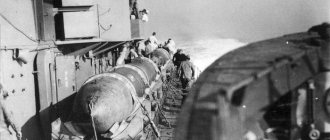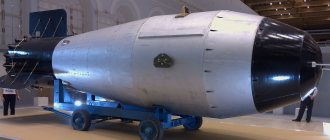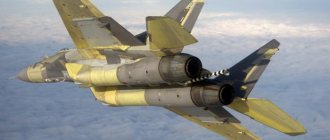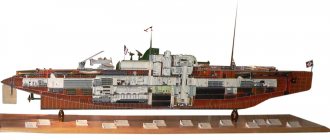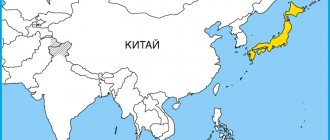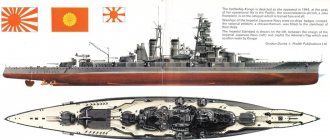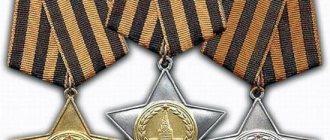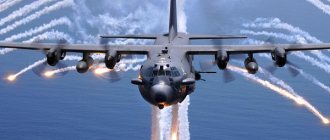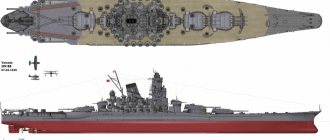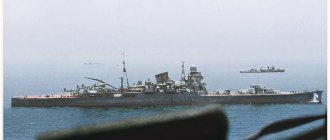Author: Sergei
24 July 2022 20:29
Tags: Japan World War II history
17168
8
“The three biggest and most useless things were created in the world - the Great Wall of China, the Egyptian pyramids and the Japanese Yamato-class battleships,” says a Japanese proverb.
0
See all photos in the gallery
But it’s true that the largest battleships in the history of mankind - these indestructible monsters, thousand-ton steel monsters - were never able to fully reveal their potential, and they actually appeared at the end of the dreadnought era, when a new striking force had already taken its place. fleet - aircraft carriers.
A total of four ships of this class were laid down. Only two of them, the Yamato itself and the Musashi, were completed and participated in the combat operations of the Imperial Navy, the fourth was dismantled on the slipway, but the third had a very unusual, but tragic fate.
×
Death of Musashi
0
"Musashi" received about 12 torpedoes and 10 bombs and also struggled for buoyancy for a long time.
0
After the defeat at the Battle of Midway, the Japanese fleet could be said to be left without aircraft carriers. Losing 4 of the best heavy aircraft carriers and almost 250 aircraft in one battle is very, very noticeable. And something had to be done about this. Considering the relatively low speed of shipbuilding in Japan and the shortage of materials, it was decided to urgently convert existing ships, such as passenger liners, or unfinished projects into a kind of ersatz aircraft. The admirals' attention was drawn to the half-finished third ship of the Yamato class - No. 110. The realization of the uselessness of battleships in the Pacific Ocean had already come, and there was not much money for completion, so in the summer of 1942, No. 110 began to be completed as a heavy aircraft carrier and was named "Shinano". Literally everything about it was heavy, from its displacement to the engineers’ headaches about how they could turn a good battleship into at least an average aircraft carrier. Instead of being the world's largest and most useless battleship, Shinano was destined to become the world's largest and most useless aircraft carrier. The launch of the new ship took place on October 8, 1944, outfitting work continued urgently at the naval shipyard in Yokosuka, but within a month the American B-29 superfortresses were already reaching the shipyard and were potentially dangerous for the ship. The management decided to transfer it out of harm’s way to the base in Kure, which is located on the other side of Japan, and there carry out final development and acceptance.
0
2,176 sailors and officers, 300 shipyard workers and about 40 various civilians boarded the ship. While the aircraft carrier was preparing to depart, all idle hands were riveting, welding, painting, caulking, in general, finishing the ship's mechanisms and systems. On November 19, 1944, Shinano was officially introduced into the fleet. Only the best of the best should command the pride of the fleet. This turned out to be captain Toshio Abe. Just two years earlier, at Midway, he had commanded a division of destroyers. Now he is already standing on the bridge of the very, very ship in the world. Such an unimaginable career growth quite clearly gives an idea of the general state of affairs in the ship’s crew. The sailors, of course, knew their job, but many of them were “green” training graduates, and the rest were sorely lacking in experience, dexterity, and proper fighting spirit.
The tip of the spear. The real number of aircraft carriers Japan has and their capabilities
When considering Japan's buildup of military power, two things must be understood very clearly. The first is that the Japanese lie in military matters. And secondly, they know how to show things not as they really are. Japan's military programs are a perfect illustration of both theses.
The format of a single article does not allow for a detailed analysis of what the Japanese actually have and what they can get for themselves in a short (several months) time if they remove political restrictions on military development. You will also have to leave outside the material the social background to what the Japanese are doing and hiding.
Nevertheless, for the sake of interest, using the example of the Japanese aircraft carrier program, we can consider the difference between the reality of Japanese military development and the “dust” that Japan truly brilliantly throws into the eyes of both allies and adversaries.
In the modern world, it is almost impossible to hide significant facts. It is impossible in a society where everyone has a camera phone and the Internet to hide an aircraft carrier or the transfer of an airborne division. Therefore, in order to mislead the enemy, the so-called cognitive distortion is initiated - a situation when the enemy sees reality, but his mind refuses to perceive it objectively. There are many examples in history. So, in June 1941, many Soviet commanders of units and formations not only knew that the war would begin literally the other day, but also knew the numbers of the German divisions opposing them, the names of their commanders, and heard at night the clearly identifiable noise from mechanized formations being transferred to the border , saw German reconnaissance groups - and still the enemy managed to achieve surprise. In 2015, all summer long the Internet was full of photos of Russian UAVs and soldiers in Syria, then videos of aircraft being transferred, but Russia’s open intervention in this war came as a surprise to the world. Everyone saw everything... but didn’t believe it.
As a result of the cognitive distortion supported by the Japanese, clichés are born: “The Japanese Self-Defense Forces are an appendage to the US Armed Forces, incapable of independent action,” “an anti-submarine fleet,” and the like. Lost behind these clichés are the tests of medium-range ballistic missiles (under the guise of ultra-light launch vehicles), and the already achieved technical superiority over the United States in light anti-ship missiles, the second largest anti-submarine aviation in the world, the surface fleet, and almost the largest number of warships in the ocean zone. twice the size of all Russian fleets combined, preparations for the production of long-range cruise missiles and much more. The ability to build a reactor producing weapons-grade plutonium is also there, behind the veil of stereotypes. Although the experts here know how it really is, it’s still a sensitive topic, and “about nine months before the bomb” was where it should have been voiced a long time ago...
Japan's aircraft carrier program is a prime example of this cognitive bias. The opinions that both ordinary people and even experts have about it, as a rule, are completely at odds with reality and reflect not the reality itself, but the simulacrum with which the Japanese are trying to cover up their preparations. The clearest example of the point of view of its fleet that Japan is trying to “push through to the masses” is the latest article by Dmitry Verkhoturov “Japan already has an aircraft carrier”
. It certainly deserves to get acquainted with it - this is the same distorted version of reality that the Japanese forced Dmitry Verkhoturov and, frankly, most of humanity to believe.
Now let's look at what reality looks like.
Back in the late nineties, it became obvious to the “elites” of Japanese society that the Japanese as a people had fallen into a severe systemic crisis. And it wasn't about economics. The point was that the development of the Japanese as a nation had stopped, that society as a whole had taken the path of degradation, at the end of which death. Infantilism, degeneration, demographic crisis, reluctance to fight for a better life were only some of the particular symptoms. If for the Japanese youth of the past the values were high-quality education, work and family, and earlier, in the days before the Second World War, also military service, then by the end of the twentieth century “the fire went out”, the strength of the nation ended. Young people were mired in children's entertainment, the average age of the population was growing rapidly, and the birth rate was falling. This is, in general, still the case today.
One of the consequences of all this was the appearance of an interesting document - “Japan’s Goals in the 21st Century”, from which it clearly followed that in order not to lose competitiveness in the future (and not only industrial), the Japanese need to improve the quality of their human potential. Improve people. People were considered by the authors of the report as the very “decisive link”, by pulling which the entire chain can be pulled out.
And then rapid militarization began. It is difficult to say what the Japanese decision-making mechanism was, but we will give them their due - without militarization, people who have completely lost the desire to live cannot be made into a fighting nation. And without a fighting spirit there are no victories, no achievements, only defeats and not necessarily military ones. The military threat, like military romance, stimulates emotions, generates self-confidence, and, as a result, makes a person stronger and more active. What was and is necessary.
One of the aspects of the beginning militarization was the beginning of work on the revival of the aircraft carrier fleet, which began at the same time, in the late nineties. After all, for an island state, military strength is a fleet, and what kind of fleet is it without aircraft carriers? Everything was natural.
However, here it was necessary to somehow get around the factor of the American “gentlemen”. The Gaijin, who defeated the country of Yamato and occupied its entire territory at one time, called themselves “allies,” but they were more like masters than allies. The Americans remembered very well how many problems they had with Japan, which was technologically inferior to them. It is difficult to say how they would evaluate a full-scale renaissance of the Japanese military machine, and the Japanese did not take risks. There are areas of armaments in which the Americans not only do not interfere with their allies, but openly help and stimulate them. One of these types of weapons is light escort aircraft carriers.
In the 70s, the commander of US naval operations, Admiral Elmo Zumwalt, proposed recreating the concept of an escort aircraft carrier at a new technical level. This was the famous Sea Control Ship project - a sea control ship. Its tasks were simple - to protect convoys with military cargo and troops from Soviet submarines in the Atlantic with the help of deck-based anti-submarine helicopters, and if a Tu-95 RC, or a hypothetical long-range missile carrier (they later appeared), was on the horizon, then deck-based "Harriers" should have dealt with him. Congress did not give Zumwalt money for this endeavor, but the completed project went to Spain, which built its “Prince of Asturias” on its basis. Before this, back in 1967, the Americans transferred to Spain the light aircraft carrier Cabot from World War II, which served the Spaniards until 1989. By the eighties, the British had built a series of light aircraft carriers, and the Italians had built the Garibaldi, similar to the SCS, so there was no one to work in the Atlantic without the SCS.
In the early 2000s, massive supplies of weapons to China from Russia were already a fact, the strengthening of China was already quite visible and the construction of a light anti-submarine ship, declared as a helicopter-destroyer - a helicopter-carrying destroyer, did not cause any fears among the “owners”. And the Japanese took care in a very unique way to ensure that it did not cause any fears among potential enemies.
In 2006, the lead ship of 16DDH “Hyuga” was laid down. And in 2009 he was introduced into the combat ranks of the Naval Self-Defense Forces.
The Japanese announced an air group of 4 helicopters. This caused a lot of confusion on the part of observers - a ship with a total displacement of 18,000 tons, a through flight deck, two helicopter lifts and only four helicopters as the main weapon looked strange. The Japanese, however, shrugged their shoulders and said something like this: “We are a peaceful country and have refused to resolve issues through force. Therefore, you should not be surprised that on such a ship we have only four helicopters. For peacetime tasks, no more is needed, but in case Japan is attacked, we can add a certain number of helicopters. Maybe twelve or maybe fourteen - depending on what kind of helicopters. Yes, and you need to understand that we have crew quarters there, and they require internal volumes. Overall, don't worry. This is a small ship, it cannot threaten anyone, although indeed, it can carry more helicopters if necessary.” Approximately this point of view literally spread from the Japanese specialized press further, through English-language reference books and then everywhere. And the ship did not have a springboard, and Japan did not have and did not intend to purchase vertical take-off and landing aircraft.
A year later, the Japanese showed an image of their future larger ship - the Izumo class. And they immediately started a rumor that this project might be capable of carrying airplanes, and “Hiyuga” is just that, a training exercise. It will insure ships with its anti-submarine helicopters. This took the attention away from Hiyugi and his sistership Ise.
This is approximately how the public still evaluates this ship. The Japanese have ensured that this point of view of their “destroyer” has become the dominant one; they even take all photos of this ship from such an angle that it is quite difficult to estimate its size. Although they are even on Wikipedia, but who will look at them there...
But we will try to estimate the dimensions and look at reference materials. Let's look at the picture.
And the veil falls! "Hyuga" is quite a large and full-fledged aircraft carrier ship. In this image he is perceived to be exactly the same as the British "war hero" in the Falklands - "Invincible-class". The same type of ship that provided the Britons with the possibility of a transcontinental war on the other side of the planet, relative to their home territory. And, true, “Hyuga” is just a little smaller than “Invincible”. But a considerable air group can be based on the latter.
For comparison, the previous image has added the Thai "Chakri Narubet" - the latest reincarnation of SCS. Here it is - small, carrying eight planes in total. "Hyuga" is significantly larger.
So, it turns out that these ships were built as full-fledged aircraft carriers? Almost. In order for F-35Bs to launch from Hiyuga, they need to cover the deck with a heat-resistant coating, as the Americans had to do on the Wasp-class UDC, and mount a springboard, as the British did. After this, the F-35B will calmly and without problems take off from this ship and land on it. Ideally, you also need a gas deflector at the launch position, then parking aircraft behind the launch position will not interfere with takeoff. But how many such aircraft can the ship carry?
To do this, let's pay attention to his hangar. According to Western sources, the dimensions of the Hiyugi hangar in feet are approximately 350x60x22 (foot 0.3048 meters). This is almost the same as on Waspa. Of these, about 60% of the area is available for storing aircraft outside the lifts, that is, an area measuring about 66x18 meters (the exact dimensions are unknown). The F-35B's wings do not fold and their wingspan is just under 11 meters. The length of the aircraft is 15.6 meters. In a rectangle of 22x18 meters you can place 2 of these aircraft in a checkerboard pattern, “nose to wing”. At the same time, there will be enough space around for walking and carrying tools and equipment, including bulky ones. More dense arrangement options are also possible. In total, at least 6 F-35s can be placed outside the lifts. However, in the West (and technologically Japan is the “West”) the so-called. deck parking. With it, more aircraft are taken onto the ship than can fit in the hangar, and some of the aircraft are always on deck. You can “register” up to four F-35Bs on the deck of the Hiyugi, and there will be room for another two or three helicopters with folded blades (in front of the island). Or an F-35B and a helicopter.
Thus, after installing a springboard and a gas deflector (which is never a problem for the Japanese shipbuilding industry) and re-laying the deck covering (the destructive power of the F-35B exhaust was a surprise to everyone at one time), the Hiyuga will be able to carry up to 10-11 fighters and 2 -3 helicopters. A fully-fledged escort, and even with 16 missile cells, sonar, torpedo tubes and Phalanx anti-aircraft guns. One such ship will be able to cover the transoceanic passage of a rather large convoy, depending on the composition of the air group (proportions between anti-aircraft helicopters and fighters), and will be able to intercept enemy patrol aircraft, fight aerial reconnaissance, and sink single ships or small groups of them with air strikes. For the KPUG of the Chinese Project 056 corvettes, this ship will simply become the scourge of God. Its firepower is enough to support a small landing operation, say, of a battalion scale. A couple of such ships are already integrally half of the Russian air group in Syria in terms of air power.
"Hyuga" entered service in 2009, sistership "Ise" in 2011. It was during these years that Japan actually acquired an aircraft carrier fleet. I just didn't tell anyone about it. After all, it won’t take long to install diving boards and re-lay the deck. And it’s not difficult to make a gas separator. The only question was essentially buying planes, but where were they in a hurry in 2011?
It's funny, but the first who could not “keep their mouth shut” were toy manufacturers. The picture below is a correctly scaled image of the Hiyugi with an F-35B and a British Harrier, taken for advertising purposes. A toy, but appreciate the scale, as they say.
However, these were “trial balloons” - it is inconvenient and difficult to wage a serious war with such ships, more are needed.
A year after the delivery of Ise, the Japanese laid down the lead ship of the new Izumo class. This time the ship was much larger. The lead aircraft carrier was delivered to the customer in 2015, and its sister ship Kaga flew the flag with the rising sun in 2017. According to Jane's (now shabby everywhere), the ship could carry up to 28 aircraft of various types. But the Japanese again stated that there would be nine of them, and that they would only be helicopters. And again, the same song: “we are a peaceful country...”, the photos are 3/4 in which it is difficult to estimate the size of the ship.
But you can't hide the truth.
The ship is already really big, and it is possible that the Japanese lied about the displacement. A purely helicopter deck for such a giant is ridiculous.
And this year, just recently, the Japanese finally admitted that yes, they will convert it into an aircraft carrier. The ship will supposedly be able to carry up to ten F-35Bs... but we’ve already heard about four helicopters on the Hiyuga, right?
We look at the hangar at Izumo. In feet approximately 550x80x22. This is twice as much as Wasp. At the same time, the stern lift is located on board and does not take up aircraft storage space. Having measured the hangar in the same way as on the Hiyuga, we come to the conclusion that at least 14 F-35Bs can be placed in its hangar, and again without cramping. And if you stuff them there wing to wing, then perhaps more. A quick glance at the deck indicates about 6 or 8 more planes and 4-6 helicopters. This is approximately the same as that of the Wasp, and this is logical, since the ships are almost the same in size, only the Wasp will have to store more equipment on the deck.
Thus, even a superficial analysis shows that Japan is actually preparing right now to receive a couple of aircraft carriers, each of which will have at least twenty fighters and a number of helicopters, and has two more potential auxiliary class aircraft carriers in reserve.
It is worth noting that the forty fighters with short take-off/vertical landing, the purchase of which Japan announced, are just two air groups for the Izumo pair; the Japanese are not talking about Hiyugi yet. They are a peaceful country. A little while later, when everyone gets used to Izumo...
So the Japanese potentially have four aircraft carriers, including two light ones and a pair of so-called “medium” ones. The latter will appear in their real guise very soon.
However, one must understand that two or four Japanese aircraft carriers are only the tip of the spear of Japanese air power. The spear itself is on the islands, and cannot be reduced to carrier-based aircraft. Currently, the Self-Defense Forces Air Force has more than seventy deeply modernized Phantom F-4 fighter-bombers, each of which is capable of carrying a pair of Japanese ASM-1 or ASM-2 anti-ship missiles, the first of which is roughly similar to the Russian X-35 or American anti-ship missiles “Harpoon”, and the second is similar to the first except for the guidance system; instead of the radar seeker, it uses infrared guidance. Recently, the Japanese demonstrated a new generation of missiles with the same dimensions and the same range - the experimental supersonic “three-mach” XASM-3. They should begin arriving in combat units in the near future.
There are also sixty-two newer Mitsubishi F-2 multirole fighters, which are a further development of the American F-16. These aircraft are capable of carrying up to four anti-ship missiles, a pair of external fuel tanks simultaneously with air-to-air missiles for self-defense.
When waging an offensive war over the sea, air groups from aircraft carriers are capable of conducting air reconnaissance over a large water area, detecting enemy naval strike groups (in the case of China, also aircraft carriers), destroying ships deployed on radar patrol, and providing continuous target designation for coastal aircraft, which will strike at the target with its hundreds of anti-ship missiles. And the deck crew will record the result of the strike and finish off the survivors with bombs if necessary. For a mosquito fleet, a couple of dozen F-35Bs will be simply a terrible threat; the Iranian Operation Pearl in 1980 clearly showed what a terrible danger even a small number of aircraft poses to a small fleet. Landing ships, supply transports, individual warships, obsolete warships, landing troops uncovered from the air on the shore, stationary objects - all this for an air group of a couple of dozen fifth-generation fighters are easy targets, even despite the shortcomings of the F-35B as a combat aircraft .
In addition, one should not underestimate the capabilities of this machine in guiding missile weapons and intercepting air targets (for example, attack aircraft attacking a Japanese KUG, loaded with missiles and unable to maneuver). And for attacks on surface targets, coastal aircraft directed by an air group are quite suitable. During their attacks, deck crews may well carry out a false attack, drawing away enemy aircraft or attention, and strengthen their attack with their own, from a different course, and carry out an escort and take over enemy interceptors. They are also capable of “covering” their missile salvo from URO ships or closing the sky above the water area for enemy anti-submarine aircraft, providing comfortable conditions for the operations of their submarines.
And of course, our own anti-submarine aircraft will operate quite calmly over the areas of operation of carrier-based fighters. Closer to the shore, base fighters would have escorted it, but at a great distance this is inconvenient, refueling will be needed in the air, and Japan has few refuelers, and there will be enough for them to do more important work. And here the deck workers come in handy.
In fact, even with a pair of converted Izumos, Japan is already capable of carrying out an operation comparable to the British Falklands War. The only thing missing is supply ships, and one or two more landing ships are needed. Or land troops on the Hiugi and deploy combat helicopters on them to support it - there is a place there. And that’s all, you just need to retrofit both Izumos as promised.
And we still fantasize about the fact that “they can’t do anything without the Americans.”
This is how reality differs from Japanese mirages. Militarism in Japan, by the way, is slowly growing. Thus, a manga (don’t laugh) about the battles of a Japanese carrier strike group against the Chinese has gained serious popularity. They're even making a movie based on it. A - DDH-192, a fictional Izumo-class aircraft carrier converted to host the F-35B.
However, the real aircraft carrier Izumo may look something different.
Of course, such militarism still causes laughter. True, the Japanese have already participated in military operations abroad, and Abe recently hosted a very large-scale military parade... but the Japanese do all this very slowly, without attracting attention. After all, they need those around them not to see all these changes, but to continue to see that old reality, which will soon begin its “departure.” So that no one worries. "We are a peaceful country..."
They do everything quietly. Without attracting attention, diverting other people's views in the direction they need, and skillfully using cognitive techniques to influence people's consciousness. Are you taking into account four Japanese aircraft carriers? But they exist. And so it is in everything. And the Americans are no longer at all opposed to the Land of the Rising Sun reviving the samurai spirit. After all, there is a fight with China ahead. And such an ally would be very welcome in her.
And our analysts can still fantasize carnivorously about future battles between the Japanese and the Chinese for the Senkaku Islands. After all, it is the issue of the islands that causes maximum tension between Japan and China. And the Japanese are clearly preparing for a confrontation with them.
Unless you take into account a couple of important facts. First: the Japanese lie in military matters. And second: they know how to show things not as they really are.
Frame
The flight deck measuring 261.5x29.9 m was integrated into the ship's hull and contributed to its longitudinal strength. The aircraft carrier's bow was completely enclosed, right down to the flight deck, to improve aerodynamics and seaworthiness. Under the flight deck there are two hangars located one above the other, the upper one measuring 157×22.5 m and the lower one measuring 157.5×22.5 m, both heights are 5 m. The “island” of the ship in plan resembled a section of a wing, was located on a special sponson and was combined with a chimney, which had a slope of 26° to the right side to remove gases from the flight deck.
Body section
Characteristics of light aircraft carriers of the Unryu series
A country:JapanType:Light aircraft carrierDate of issue:Laid down 08/01/1942, launched 09/25/1943, entered service 08/06/1944Displacement:Total: 22,400 tonsLength:227.4 metersWidth:22 metersDraft:7.8 metersReservations:see textCrew:1595 peoplePower point:152,000 hpTravel range:8,000 milesMaximum speed:34 knotsWeapons:12x127mm, 51(89)x25mm, 6x28x120mm PUAir group:63 aircraft
By the beginning of World War II, the Japanese naval command had already assessed the power of large aircraft carrier formations of ships and came to the conclusion that serial construction of aircraft carriers was necessary. As part of the “Fifth Fleet Replenishment Program” of 1940, among other things, 6 new aircraft carriers (Unryu type) were listed at once. The aircraft carrier Hiryu was chosen as the prototype of the new series, as a compromise between the combat characteristics of the ship and its cost.
Aviation weapons
The estimated composition of the ship's air group was supposed to be from 61 to 75 aircraft. It was to include new types of Mitsubishi A7M2 Reppū Aichi B7A2 Ryusei torpedo dive bombers Nakajima C6N1 Saiun reconnaissance aircraft . The arrangement of aircraft on board was provided as follows: fighters and reconnaissance aircraft in the upper hangar, and bombers - torpedo bombers - in the lower one.
Mitsubishi A7M2 Reppu "Sam"
Aircraft carrier group "Unryu"
The composition of the aircraft carrier air group underwent significant changes as work progressed. According to the project, it was envisaged to have in the air group:
- 18 A6M5c fighters + 2 reserves
- 18 B7A Ryusei attack aircraft + 2 reserve
- 4 reconnaissance C6N1 "Saiun".
Do you know that…
...Japanese Lieutenant Yoshida Mitsuru was on the Yamato at the time of its death and described
your impressions in your memoirs?
However, “Unryu” was “in fact” based on 12 (+2 reserve) A6M2 fighters, 18 (+2 reserve) D4Y1-C reconnaissance aircraft and 18 (+3 reserve) D4Y1 dive bombers, and during the Philippine campaign - 48 A6M5 fighters, 4 reconnaissance and anti-submarine aircraft Ki-76, that is, the composition of the air group could change depending on the tasks being solved.
Two aircraft lifts had a size of 14x14 m for new types of aircraft; a 9-cable aerofinisher and 3 emergency barriers were used to receive aircraft (3 cables and one barrier in the bow of the flight deck and 6 cables and 2 barriers in the stern). The Type 3 barrier was capable of stopping an aircraft weighing up to 6,500 kg performing an emergency landing.
Power plant and driving performance
Four turbo-gear units with a total power of 160,000 hp. and each included a high-pressure turbine, a medium-pressure turbine with a cruising turbine and a low-pressure turbine, located in four engine rooms. Between the two bow and two stern engine rooms, eight oil-fired steam water-tube boilers of the Kanpon Ro-Go system, a large version, were installed, each in a separate boiler room. All chimneys were combined into a common chimney. The aircraft carrier's four-shaft propulsion system was supposed to provide it with a maximum speed of 33 knots.
Armament
Auxiliary/anti-aircraft artillery
The artillery armament consisted of eight twin 10 cm/65 Type 98 anti-aircraft guns. The installations had an electro-hydraulic drive and were located on the side sponsons, four on each side below the flight deck level. The gun crew consisted of 11 people, the average rate of fire was 15 rounds per minute. The ship's air defense also included 22 three-barreled 25 mm/60 Type 96 Model 1 anti-aircraft guns. The guns had a rate of fire of 110-120 rounds per minute and a maximum range of up to 3 km.
100 mm Type 98 anti-aircraft gun
25 mm anti-aircraft machine gun type 96
Booking
The flight deck was covered between the lifts with armor plates 95 mm thick. and was intended to protect against dive bombers attacking from a height of up to 2500 m. The lifts themselves also had a 5-mm armor coating. The horizontal armoring system also included a 48-mm armored hangar deck, which was the floor of the lower hangar; the floor of the upper hangar was not armored. An armor belt 55 mm thick covered the hull and reached the height of the lower hangar deck. At the level of ammunition magazines, aviation gasoline tanks and tiller compartments, its thickness increased to 152 mm. The anti-torpedo protection consisted of a large number of waterproof compartments and had to withstand the explosion of a 350 kg charge. Two longitudinal bulkheads 76 mm thick passed through the compartments, located 3 m from the side plating and rigidly connected to each other. They were a continuation of the armor belt. Fuel tanks were additionally protected by concrete blisters.
This is what an aircraft carrier would have looked like in 1945
Project history
After the battle at Midway Atoll, which ended in a major defeat for the Japanese fleet, the issue of urgently making up for the losses suffered came to a head. To speed up construction, the design of the new aircraft carrier was simplified in order to unify it with existing mechanisms and equipment.
This took some time, and only at the end of 1942 were the first three aircraft carriers planned for construction laid down. Construction of the next three began in 1943.
The first three ships of the Unryu series were laid down at the end of 1942, the remaining three in 1943. At the same time, the updated shipbuilding program adopted in 1942 provided for the construction of another 11 aircraft carriers of the Unryu type and 8 Taiho type. All this mass of ships managed to be assigned only serial numbers: 800, 5002, 5005, 5008-5015, but construction did not even begin.
Aircraft carrier "Amagi" on a cruise
The hull of the Unryu-class aircraft carriers was almost exactly the same as the Hiryu, but unlike the prototype, the island superstructure was moved to the starboard side and significantly expanded. Her increased weight was compensated by the increased width of the hull above the waterline on the port side.
To increase the overall strength of the flight deck, the number of aircraft lifts was reduced to two, bow and stern, and the structure of the flight deck itself was strengthened. The armor belt had a thickness of 25 mm and extended throughout the engine and boiler rooms, fuel tanks and ammunition magazines, above it there was an armored deck 45 mm thick.
Compared to the original version, much more attention was paid to torpedo protection and survivability: the bulges built into the hull were separated by a large number of waterproof bulkheads and equipped with a drainage system, and a 50-mm anti-torpedo bulkhead was installed; the aircraft refueling and weapons suspension stations were moved to the flight deck, the hangars were equipped with fire-resistant shutters and modern fire extinguishing systems. The ammunition cellars and aviation gasoline tanks were additionally protected by concrete-filled compartments; in addition, to reduce the risk of fire, the capacity of aviation gasoline tanks was limited to 216,000 liters.
Despite the measures taken, all Japanese light aircraft carriers (Unryu and Hiryu) were quite vulnerable ships. The relatively small displacement did not allow the placement of either an armored flight deck or sufficiently powerful anti-torpedo protection. Therefore, a special tactic was developed for the interaction of a formation of Unryu-class aircraft carriers with a well-armored and protected support aircraft carrier Shinano. Aircraft taking off from Unryu-class ships after striking the enemy had to land on the Shinano, where they were prepared for a new flight, while the aircraft carriers themselves would have moved beyond the range of their aircraft by the time the enemy responded.
Aircraft carrier "Unryu"
The aircraft carriers "Unryu", "Amagi", as well as the same type, but unfinished "Kasagi" and "Ikoma", received main mechanisms similar to those of the aircraft carriers "Hiryu", "Soryu" and cruisers of the "Mogami" type. On the ships built in Kure (“Katsuragi” and “Azo”), mechanisms of a different type were installed - two sets of standard destroyer turbine units, adapted for placement in the engine rooms of aircraft carriers. Despite the lower power - 104,000 hp. instead of 152,000 hp - the difference in maximum speed was not too great: during testing, the Unryu developed 34 knots, while the Katsuragi - 32.7. All ships in the series were equipped with 8 Kanpon model “Ro-go” large version boilers.

